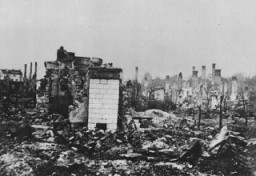You searched for: %E6%B3%95%E5%85%B0%E8%A5%BF%E5%A0%A1%E8%B5%8C%E5%9C%BA%E7%BD%91%E5%9D%80%2C%E7%BD%91%E7%BB%9C%E8%B5%8C%E5%8D%9A%E5%B9%B3%E5%8F%B0%E3%80%90%E5%A4%8D%E5%88%B6%E6%89%93%E5%BC%80%E2%88%B6www.766yule.com%E3%80%91%E5%8D%9A%E5%BD%A9%E5%B9%B3%E5%8F%B0%2C%E5%8D%9A%E5%BD%A9%E7%BD%91%E5%9D%80%2C%E6%B3%95%E5%85%B0%E8%A5%BF%E5%A0%A1%E7%BD%91%E4%B8%8A%E8%B5%8C%E5%9C%BA%E5%9C%B0%E5%9D%80%2C%E7%BD%91%E4%B8%8A%E5%8D%9A%E5%BD%A9%E6%B8%B8%E6%88%8F%E5%B9%B3%E5%8F%B0%2C%E6%B3%95%E5%85%B0%E8%A5%BF%E5%A0%A1%E5%8D%9A%E5%BD%A9%E5%85%AC%E5%8F%B8%2C%E7%9C%9F%E4%BA%BA%E5%8D%9A%E5%BD%A9%E6%B8%B8%E6%88%8F%E7%A7%8D%E7%B1%BB%2C%E8%B5%8C%E5%8D%9A%E6%B8%B8%E6%88%8F%E7%A7%8D%E7%B1%BB%2C%E6%AD%A3%E8%A7%84%E5%8D%9A%E5%BD%A9%E5%B9%B3%E5%8F%B0%2C%E3%80%90%E6%89%93%E5%BC%80%E5%8D%9A%E5%BD%A9%E7%BD%91%E7%AB%99%E2%88%B6www.766yule.com%E3%80%91%E7%BD%91%E5%9D%80KsNhssCBMhyBNhyX
<< Previous | Displaying results 101-150 of 220 for "%E6%B3%95%E5%85%B0%E8%A5%BF%E5%A0%A1%E8%B5%8C%E5%9C%BA%E7%BD%91%E5%9D%80%2C%E7%BD%91%E7%BB%9C%E8%B5%8C%E5%8D%9A%E5%B9%B3%E5%8F%B0%E3%80%90%E5%A4%8D%E5%88%B6%E6%89%93%E5%BC%80%E2%88%B6www.766yule.com%E3%80%91%E5%8D%9A%E5%BD%A9%E5%B9%B3%E5%8F%B0%2C%E5%8D%9A%E5%BD%A9%E7%BD%91%E5%9D%80%2C%E6%B3%95%E5%85%B0%E8%A5%BF%E5%A0%A1%E7%BD%91%E4%B8%8A%E8%B5%8C%E5%9C%BA%E5%9C%B0%E5%9D%80%2C%E7%BD%91%E4%B8%8A%E5%8D%9A%E5%BD%A9%E6%B8%B8%E6%88%8F%E5%B9%B3%E5%8F%B0%2C%E6%B3%95%E5%85%B0%E8%A5%BF%E5%A0%A1%E5%8D%9A%E5%BD%A9%E5%85%AC%E5%8F%B8%2C%E7%9C%9F%E4%BA%BA%E5%8D%9A%E5%BD%A9%E6%B8%B8%E6%88%8F%E7%A7%8D%E7%B1%BB%2C%E8%B5%8C%E5%8D%9A%E6%B8%B8%E6%88%8F%E7%A7%8D%E7%B1%BB%2C%E6%AD%A3%E8%A7%84%E5%8D%9A%E5%BD%A9%E5%B9%B3%E5%8F%B0%2C%E3%80%90%E6%89%93%E5%BC%80%E5%8D%9A%E5%BD%A9%E7%BD%91%E7%AB%99%E2%88%B6www.766yule.com%E3%80%91%E7%BD%91%E5%9D%80KsNhssCBMhyBNhyX" | Next >>
-
Henny Fletcher Aronsen describes liberation from a death march from Stutthof
Oral HistoryHenny was born into an upper-middle-class Jewish family in Kovno, Lithuania. She and her brother attended private schools. In June 1940 the Soviets occupied Lithuania, but little seemed to change until the German invasion in June 1941. The Germans sealed off a ghetto in Kovno in August 1941. Henny and her family were forced to move into the ghetto. Henny married in the ghetto in November 1943; her dowry was a pound of sugar. She survived several roundups during which some of her friends and family were…
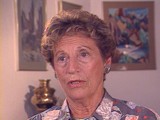
-
Life After the Holocaust: Norman Salsitz
ArticleAfter WWII and the fall of the Nazi regime, Holocaust survivors faced the daunting task of rebuilding their lives. Listen to Norman Salsitz's story.
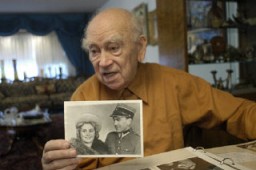
-
Peter Black describes the role of historians in researching war crimes cases for OSI
Oral HistoryIn the 1980s and 1990s, historian Peter Black worked for the US Department of Justice Office of Special Investigations, as part of a team tracking and prosecuting suspected war criminals. Black later served as the Senior Historian at the United States Holocaust Memorial Museum.
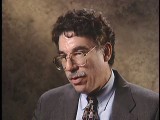
-
How did the Nazis and their collaborators implement the Holocaust?
Discussion QuestionWhen Nazi Party leader Adolf Hitler became German chancellor on January 30, 1933, no step-by-step blueprint for the genocide of Jews as a “race” existed. After the outbreak of World War II, millions of Jews came und...

-
Lend-Lease
ArticleLearn more about the Lend-Lease Act, which was the American policy that extended material aid to the WWII Allied powers from 1941-1945.

-
The 69th Infantry Division during World War II
ArticleThe 69th Infantry Division participated in major WWII campaigns and is recognized for liberating the Leipzig-Thekla subcamp of Buchenwald in 1945.
-
Lithuania
ArticleAs part of the Holocaust, the Germans murdered about 90% of Jews in Lithuania. Read more about the tragic experience of Lithuanian Jews during World War II.

-
Insignia of the 101st Airborne Division
PhotoInsignia of the 101st Airborne Division. The nickname of the 101st Airborne Division, "Screaming Eagles," originates from the division's insignia, a bald eagle on a black shield. "Old Abe" was the eagle mascot of a Wisconsin regiment during the Civil War. The 101st was formed as a reserve unit in Wisconsin shortly after World War I and included "Old Abe" as part of the division's insignia.
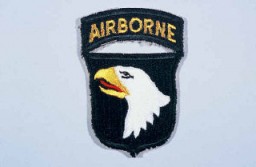
-
Terez Goldberger Kalman
ID CardTerez came from a religious Jewish family. She and her husband, Samuel, raised eight children in Satoraljaujhely, in northeastern Hungary. The Kalmans lived on the outskirts of the city, and in the 1920s they ran a canteen for the soldiers who lived in the nearby barracks. The Kalmans were proud Hungarians; one of their sons had died in World War I. 1933-39: Since Samuel died a few years ago, Terez has been alone here in her house in Satoraljaujhely. Many of her children live nearby, though, so her home…
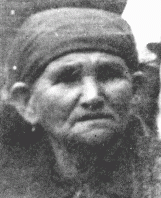
-
The 101st Airborne Division during World War II
ArticleThe 101st Airborne participated in major WWII campaigns and is recognized for liberating the Kaufering subcamp of Dachau in 1945.
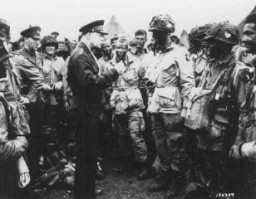
-
Nazi Persecution of Jehovah's Witnesses
ArticleJehovah's Witnesses were subjected to intense persecution under the Nazi regime. Read more to learn why and how the Nazi regime targeted them.

-
Theresienstadt
ArticleThe Theresienstadt camp/ghetto served multiple purposes during its existence from 1941-45 and had an important propaganda function for the Germans. Learn more.

-
Aliyah Bet
ArticleLearn more about Aliyah Bet, the clandestine immigration of Jews to Palestine between 1920 and 1948, when Great Britain controlled the area.

-
Persecution of Roma (Gypsies) in Prewar Germany, 1933–1939
ArticleBeginning in 1933, the Nazis persecuted Roma (often pejoratively called “Gypsies”) based on underlying prejudices and racism. Learn how this harassment escalated to genocide.

-
Ban on Jehovah's Witness Organizations
Timeline EventApril 1, 1935. On this date, the German government banned all Jehovah's Witness organizations.

-
Norbert Wollheim describes his experiences on a transport during deportation from Berlin
Oral HistoryNorbert studied law and was a social worker in Berlin. He worked on the Kindertransport (Children's Transport) program, arranging to send Jewish children from Europe to Great Britain. His parents, who also lived in Berlin, were deported in December 1942. Norbert, his wife, and their child were deported to Auschwitz in March 1943. He was separated from his wife and child, and sent to the Buna works near Auschwitz III (Monowitz) for forced labor. Norbert survived the Auschwitz camp, and was liberated by US…

-
International Military Tribunal: The Defendants
ArticleListing of the 24 leading Nazi officials indicted at the International Military Tribunal at Nuremberg. Learn about the defendants and the charges against them.
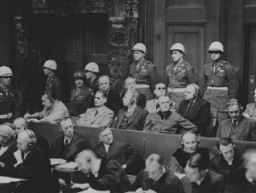
-
Halle
ArticleHalle an der Saale was a satellite camp of Buchenwald concentration camp. It was established by the Nazis in Saxony, Germany in 1941.
-
Theresienstadt: Cultural Life
ArticleDespite terrible living conditions and the constant threat of deportation, there was a highly developed cultural life in the Theresienstadt camp-ghetto. Learn more.
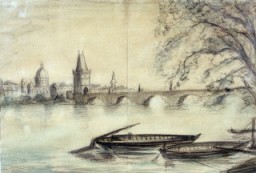
-
German Prewar Expansion
ArticleAdolf Hitler was determined to overturn the military and territorial provisions of the Treaty of Versailles. Learn more about Nazi German territorial aggression before WWII.
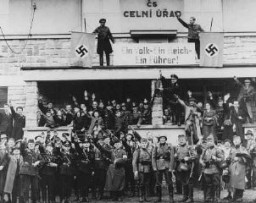
-
Austria
ArticleLearn about the German annexation of Austria, the establishment of Nazi camps, Kristallnacht, and deportations from Austria during the Holocaust.

-
Aron Tabrys
ID CardAron was the second of six children born to Jewish parents in Vilna, a city known as a center of Jewish cultural life. He was called Arke by his friends and family. Aron's father supported his large family on the meager income of a chimney sweep. 1933-39: As a child Aron attended a Jewish day school, and then went on to attend a public secondary school. When he was 14 his father had an accident which rendered him blind, and Aron had to start working full-time to support the family. Aron belonged to an…

-
Eva Gredinger
ID CardEva was one of three children born to Jewish parents in Vertujeni, a Bessarabian town that was 90 percent Jewish. Eva attended a public school. Her family was religious, attending synagogue every day. Eva's father made his living as a kosher butcher, preparing chicken according to Jewish dietary laws. 1933-39: In 1936, when Eva was 15 years old, her family moved to Vysoka, where she later got a job as a seamstress. Vysoka was very different from her hometown. There were only about 15 Jewish families in…

-
Janusz Piotrowski
ID CardJanusz was the eldest of four children born to Catholic parents in Plock, a town located in a rural area north of Warsaw. His father was an accountant. Janusz attended local schools, and became active in scouting. 1933-39: Janusz went to Warsaw to study civil engineering. On September 1, 1939, the Germans began bombing Warsaw. One week later, all able-bodied men who had not been mobilized were directed to retreat east. On September 17, Janusz was 90 miles from the Romanian border. That night, the Soviets…

-
Tomasz (Toivi) Blatt
ID CardTomasz was born to a Jewish family in Izbica, a Polish town whose largely religious Jewish community comprised more than 90 percent of the population. Tomasz's father owned a liquor store. 1933-39: In September 1939, a drum sounded in the marketplace, calling the town to assemble for a news report. Germany had invaded Poland. More news arrived shortly; the Soviet Union was invading from the east. Tomasz and his family didn't know what to do. Some people said to run to the Soviet side; many, including his…

-
William Denson describes postwar trials of concentration camp personnel
Oral HistoryWilliam Denson graduated from the US Military Academy at West Point in 1934 and attended Harvard Law School. He returned to West Point to teach law from 1942 until 1945. In January 1945, Denson accepted the position of Judge Advocate General (JAG) in Europe and was assigned to US Third Army headquarters in Germany. He took part in more than 90 trials against Germans who had committed atrocities against downed American pilots. In August 1945, Denson became chief prosecutor for the US government at the…

-
William Denson describes counsel provided to accused war criminals
Oral HistoryWilliam Denson graduated from the US Military Academy at West Point in 1934 and attended Harvard Law School. He returned to West Point to teach law from 1942 until 1945. In January 1945, Denson accepted the position of Judge Advocate General (JAG) in Europe and was assigned to US Third Army headquarters in Germany. He took part in more than 90 trials against Germans who had committed atrocities against downed American pilots. In August 1945, Denson became chief prosecutor for the US government at the…

-
William Denson describes finding witnesses for the postwar trials of concentration camp personnel
Oral HistoryWilliam Denson graduated from the US Military Academy at West Point in 1934 and attended Harvard Law School. He returned to West Point to teach law from 1942 until 1945. In January 1945, Denson accepted the position of Judge Advocate General (JAG) in Europe and was assigned to US Third Army headquarters in Germany. He took part in more than 90 trials against Germans who had committed atrocities against downed American pilots. In August 1945, Denson became chief prosecutor for the US government at the…

-
The Search for Perpetrators
ArticleThousands of Nazi criminals were never arrested. Learn more about the postwar efforts to bring Nazi perpetrators to justice.

-
Melk
ArticleLearn about the establishment of and conditions in Melk, a subcamp of the Mauthausen camp system in Austria.

-
Westerbork
ArticleThe Westerbork transit camp, located in the German-occupied Netherlands, served as a temporary collection point for Jews in the Netherlands before deportation.

-
Voyage of the St. Louis
ArticleIn May 1939, the German transatlantic liner St. Louis sailed from Germany to Cuba. Most of the passengers were Jews fleeing Nazi Germany. Learn more about the voyage.

-
Chaia Gurvitz
ID CardFrom a Jewish family, Chaia lived outside Kovno, a city with a large Jewish population that was renowned for its Hebrew school system. Chaia ran a grocery store with her husband, a retired shoemaker, and their daughter Yenta. 1933-39: Chaia is expecting her daughter Feiga, Feiga's husband, Josef, and her grandson, Abraham, for dinner. Feiga works so hard all week in her beauty shop, Chaia is glad she can help out by preparing the big Sunday meal. She has baked a special cake for Abe. Chaia hopes the…

-
Feiga Malnik
ID CardRaised in a Jewish family, Feiga lived with her husband, Josef, in Kovno, a city with a large Jewish community of 38,000. Kovno was situated at the confluence of two rivers, and with its opera company, chic stores and lively nightclubs, it was often called "Little Paris." Feiga was a beautician and Josef was a barber, and together they ran a shop in downtown Kovno. 1933-39: Every day Josef and Feiga walk to their shop, which is near their house. It's hard work, being a beautician--Feiga is on her feet…

-
Josef Malnik
ID CardRaised in a Jewish family, Josef lived with his wife, Feiga, in Kovno, a cosmopolitan city that was picturesquely situated at the juncture of two rivers and was known as the "Little Paris." Josef was a barber, his wife was a beautician, and together they ran a shop in downtown Kovno. 1933-39: Every day Josef and Feiga walk to their shop which is not far from their house. It's hard work being a barber--Josef is on his feet most of the day, seven days a week including a couple of hours on Sunday. He has…

-
Personal Stories: Jewish Partisans
ArticleBrowse a series of short biographies from the Jewish Partisan Educational Foundation.

-
Life After the Holocaust: Regina Gelb
ArticleAfter WWII and the fall of the Nazi regime, Holocaust survivors faced the daunting task of rebuilding their lives. Listen to Regina Gelb's story.
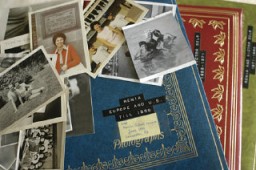
-
Passport stamped with "J" for "Jude"
PhotoPassport issued to Lore Oppenheimer, a German Jew, with "J" for "Jude" stamped on the card. "Sara" was added to the names of all German Jewish women. Hildesheim, Germany, July 3, 1939.

-
Leon Rupnik
ArticleDuring World War II, Slovene general Leon Rupnik collaborated with the forces of Fascist Italy and Nazi Germany. Rupnik was appointed president of the Provincial Government of the German-occupied Province of Ljubljana in 1943. He was convicted of treason and executed in 1946. In 2020, his sentence was annulled on a technicality.
-
William Denson describes the nature of the evidence uncovered for postwar trials of concentration camp personnel
Oral HistoryWilliam Denson graduated from the US Military Academy at West Point in 1934 and attended Harvard Law School. He returned to West Point to teach law from 1942 until 1945. In January 1945, Denson accepted the position of Judge Advocate General (JAG) in Europe and was assigned to US Third Army headquarters in Germany. He took part in more than 90 trials against Germans who had committed atrocities against downed American pilots. In August 1945, Denson became chief prosecutor for the US government at the…

-
The Aftermath of the Holocaust
Animated MapView an animated map describing some of the challenges survivors faced in the aftermath of the Holocaust, when many feared returning to their former homes.

-
Sobibor
ArticleTo carry out the mass murder of Europe's Jews, the Nazis established killing centers that used assembly-line methods of murder. Sobibor was among these facilities.

-
Röhm Purge
ArticleThe Röhm Purge (the “Night of the Long Knives") was the murder of the leadership of the SA (Storm Troopers), the Nazi paramilitary formation led by Ernst Röhm. Learn more.
-
Adolf Hitler: 1919-1924
ArticleAdolf Hitler established himself as absolute Führer, or leader, of the Nazi Party by 1921. Learn more about Hitler in the years 1919-1924.

-
Polish Victims
ArticleIn September 1939, the Germans launched a campaign of terror intended to destroy the Polish nation and culture. Learn more about the German occupation of Poland.

-
Georg Grosz
ArticleGeorg Grosz was a German artist of the Dada movement. His books, which had many of his best-known plates, were burned in Nazi Germany in 1933. Learn more.

-
Moringen Youth Camp
ArticleThe Moringen camp was one of the so-called youth protection camps that the Nazi regime established for young people who were alleged to have strayed from Nazi norms and ideals.
-
The United States: Isolation-Intervention
ArticleWhen WWII began, most Americans wanted the US to stay isolated from the war. From December 1941, the majority rallied in support of intervention to defeat the Axis powers.

-
Antisemitism
ArticleThe word antisemitism means prejudice against or hatred of Jews. The Holocaust is history’s most extreme example of antisemitism. Learn more.
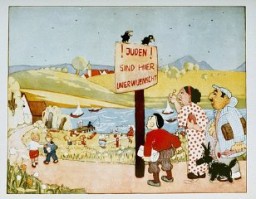
-
Blitzkrieg (Lightning War)
ArticleBlitzkrieg, meaning "Lightning War" in German, was Germany’s strategy to avoid a long war in the first phase of World War II in Europe.
